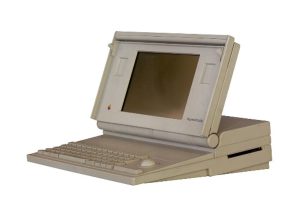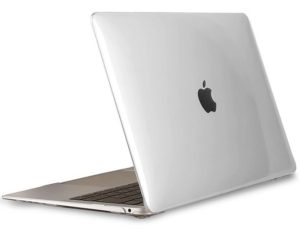

38 Years of Mac
(13 minutes of reading time) In January 24th 2022, the Macintosh (now known as the Mac) becomes 38 years old. Let's talk about this famous line of computers from Apple, which changed a lot from the original Macintosh to the present day. McIntosh is a species of apple (without the "a" in Mac), which got its name from the surname of the person responsible for the discovery, a Scottish American. By 1979 Apple was already a successful company, but it still was restricted to the hardcore market of computer enthusiasts. At that time, Steve Jobs and Steve Wozniak had created interesting models, the Apple I and II, but the company lacked a product to take off. And that model would be the Lisa, named after Steve Jobs' daughter (a daughter with whom Jobs had an extremely troubled relationship until the end of his life). The Lisa model would have the highest technical specifications of the time, a modern design, and a very high price, but fair for the technology.


Apple Lisa (1983)
Jobs was so obsessed with this computer that he made so many complaints and suggestions to the team that, in 1981, he was removed from the project as he became more of a hindrance than a helping hand. He then turns to a side project of another computer that had also been in the design phase since 1979. Jeff Raskin was the team leader for a cheaper, more intuitive product for the standard consumers. It would be discreet, with a text interface, nothing too powerful, but it would soon become Apple's great flagship. In 1981, IBM launches the PC, which becomes a sales phenomenon and popularizes the term personal computer. Apple launches the Lisa in 1983 and it was a resounding failure due to the very high price and many bugs in its operating system. And to make matters even worse, Raskin leaves the project team that was working with Jobs because of the attrition with him. Thus, the project was delayed by three years, but it comes out with everything it promised. MACINTOSH


Apple Macintosh (1984)
On January 24th 1984, Apple launches the long-awaited Macintosh with a legendary presentation by Steve Jobs and the device introducing itself by voice. It had a mouse, keyboard, and a black and white graphical interface, the first version of the Mac OS. What many people don't know is that many of these technologies were created by Xerox, which had already developed these novelties in one of its laboratories, the Palo Alto Research Center (PARC). This model, released in 1984, got known as the Macintosh 128k and had an amazing commercial movie, directed by Ridley Scott, and presented at a Super Bowl halftime show. Everything looked like it was going to work out, however, it was still very expensive and, therefore, it was not a sales success, but it became an industry icon and revolutionized the sector. Still in 1984, Apple launched a Macintosh with 512 kb of RAM and, years later, a Plus version came-out, that allowed the connection of up to seven peripherals and had 1 Mb of RAM. This one had an excellent sales performance on the market. MAC II


Apple Macintosh II (1987)
Even with all the excitement of the Mac, the end of the 80’s was a period for software and service releases. All the differences between Apple and Microsoft were put aside with the release of Word, Aldus Pagemaker and the LaserWriter printer. Still at this time, Steve Jobs was officially released from Apple and its board by the CEO John Sculley, who was recruited by Jobs. In 1987, the Macintosh II was launched, which already had a color screen and came with the best processor of its time, the Motorola 68020. Its look was also much more similar to the computers of that period, so Apple managed to balance the dispute with IBM. But from there, Apple messes everything up, because it launches several updated models with different names: Macintosh IIx, IIc, IICi and the IIfx. One more expensive than the other, which certainly wasn’t a good strategy. Still in the eighties, the company launched the Portable model, fully battery-powered and with LCD screen.


Apple Macintosh Portable (1989)
In 1990 the Classic model was launched, which readapted the original design with some modern touches. This was the last Mac model to have Jean-Louis Gassée, a controversial executive who, as product head , jettisoned low-cost products , claiming that the profit margin in high-end markets was much higher. Gassée was fired precisely for failing to deliver the products he had promised. Several lesser-known models came out in that period, such as the 1993 Macintosh TV, which had a built-in television, but was not very successful. THE ASCENSION – POWER MACINTOSH G3


Apple Power Mac G3 (1998)
In the early nineties, Apple decided to take a risk and started to use the PowerPC processor, the result of a partnership between IBM, Motorola and Apple itself. The company believed that this would be the best processor to challenge the PCs that used the Windows operating system. In March 1994, Macs with the PowerPC processor were launched, thus creating the Power Mac family. These first models were simple and in no way reminiscent of the traditional aesthetic care of the Apple brand. That's because Jony Ive, the company's famous designer, was already working there at that time, but was only promoted to head of industrial design in 1997. Another milestone for Apple this year was the return of Steve Jobs (in one of those novelistic twists). Back in the company, he cancels several products, reorganizes several areas and restarts the launching shows and conferences. The truth was that, despite all the controversies involving the person of Steve Jobs, he was very good and, with his return, Apple launched many successful products. The most successful Mac model at that time was the PowerMac G3, released in 1998. This model retired a line known as Performa and consolidated Apple as the company that values processing power and memory capacity. The G3 was the most powerful Mac ever released, and it had horizontal, vertical, and all-in-one versions. The iMac was another interesting model, a computer with the shape of a monitor, but the most important thing about it was that it was the first Apple’s “iSomething” product. Actually, it was going to be named “Mac man”, but then came the idea of including the lowercase “i” at the beginning of the name, meaning Internet and a personalization, identification with the “i” (“I” in English) of the consumers. APPLE AND A DIFFERENT LOOK


Apple iMac G3 (1998)
And that much dreamed exclusive look Apple had managed to implement in 1998 with the iMac G3: the famous computer with built-in monitor and colored and transparent back. The original blue model had 4GB of disk, 32 Mb of RAM and extras like a built-in modem and neat cable setup. The price was still very high, which made it not a sales success, but this model certainly made history. In 1999, the iBook was launched, which despite being the first Apple computer to have Wi-Fi (at the time was called AirPort), it wasn’t a very successful product. After him there were a few more generations.


Apple iBook (1999)
In the 2000s, Apple made a few more mistakes. It launched the Power Mac G4 Cube, which is considered one of the worst products in Apple's history. As its name says, it is a cube and it had design and functioning problems. Nowadays it has become something of a “cult” and popular among collectors. Its successor, the Power Mac G5, was rectangular again and was Apple's first 64-bit desktop, very powerful in terms of performance and graphics processing.


Apple Power Mac G4 Cube (2000)
In 2005 there was still the Mac Mini, a tiny case that was a complete desktop, which needed a keyboard, mouse and a screen to work. It was a cheaper and more consumer-friendly option. AND THE CHANGES HADN’T STOP In 2005, Apple drastically changed the CPU, leaving IBM processors aside and switching to Intel processors, as they offered better energy saving capabilities and compatibility with more programs and platforms. In 2006, Apple gets it right again with the Mac Pro, a workstation aimed at the professional market and with the most powerful hardware on the market. The first models had the Intel Xeon processors and a design still close to the Power Mac G5, resembling a handbag.


Apple Mac Pro (2013)
In 2013 the Mac Pro line was transformed and became a very curious product, looking like a trash can. This model was changed in 2019 and continues to this day. MACBOOK


Apple MacBook (2006)
In 2006 Apple launches the MacBook, which retired the iBook and, to this day, is the name used by the company's line of laptops. The first model launched was made of polycarbonate and was available in black and white with an Intel Core Duo processor.


Apple MacBook Pro (2010)
In 2010 comes the first MacBook Pro, with 15 and 17 inches, and a more premium style. In 2012, the Retina Display screen technology was implemented and, in 2016, the TouchBar shortcut, which was not very well accepted by the entire public. In 2018, the MacBook family was completed with the Air model, sold as the world's thinnest notebook without sacrificing keyboard size or performance, but with a full focus on portability. MacBook models are updated annually or every two years and, in 2021, Apple launched a new version with 14 and 16 inches that features the new M1 Pro and M1 Max processors, evolutions of the company's own M1 chip. They also bring the return of the MagSafe charger and bring a display of up to 120 Hz with a notch to house the camera.


Apple MacBook Air M1 (2021)
THE MAC OS SYSTEM Finally, we cannot forget to mention the versions of Apple operating systems that run on Macs. The first Macs ran on Mac OS, always with numbered updates and a focus on multitasking, however, this system became insufficient. The company tried to innovate in the mid-nineties with prototypes called Copland and Rhapsody, but none worked well. It was Steve Jobs who created the embryo of the system we see today, at the time he was away from Apple, in a company he created called NExT. Mac OS X Server 1.0 was the first of this new phase, with a revamped interface called Aqua and the Dock, the applications tray. Over time, the updates were given names, to make them better to advertise, sell and remember. From 10.0 to 10.8 were names of big cats: Cheetah, Puma, Jaguar, Panther, Tiger, Leopard, Snow Leopard, Lion and Mountain Lion. In 10.9 the naming changed to honor California landmarks, with Mavericks, Yosemite, El Capitan, Sierra, and High Sierra. In the Sierra version, the names of Apple's systems were unified with TV, watch, smartphone, and PC. Mac OS X then becomes macOS and gains a series of new features, especially in terms of visual identity and the possibility of moving tasks from one device to another. And that's the story of Macs, one of Apple's most important products from the beginning of its trajectory until today. Over time, Macs lost the prejudice that many people had of being just “expensive products”. They are widely used today by professionals in design, engineering, software development and creative production in general. Although they are still not as popular as Windows-based computers, they have their charm, their qualities, and their contribution to the history of technology and, above all, Apple itself. Do you like our content? So, follow us on social media to stay on top of innovation and read our blog. References: https://bit.ly/3tOiJnI https://bit.ly/3qK4IW8 https://bit.ly/3GP25Ia
Share this article on your social networks:
Rate this article:
[yasr_visitor_votes size=”medium”]



